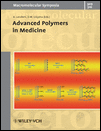Probing Polymersome-Protein and -Cell Interactions: Influence of Different End-Groups and Environments
Abstract
Developing polymersomes for drug delivery purposes requires a deeper understanding of their behavior in physiological environment. We performed the self-assembly and in-situ loading of polybutadiene-block-polyethyleneoxide (PB-b-PEO) polymersomes in a continuous process using micromixers. Varying the length and end-groups of the starting block copolymer allows us to control the polymer membrane thickness and surface functionalities (hydroxyl or carboxylic acid), required to realize a further coupling with specific cell targeting ligands. To get a deeper understanding of these polymersomes in physiological environment, we studied the cellular response (HeLa cells) in presence of various polymersomes, and showed by cytotoxicity tests the relative biocompatibility of the systems. Flow cytometry experiments at 4 °C in PBS buffer showed a different behavior of hydroxyl-functionalized vesicles compared to carboxylic acid-functionalized vesicles. On the contrary cell binding in DMEM medium supplemented with 10% FCS was almost completely blocked with both kinds of polymersomes. Protein adsorption measurements by dynamic light scattering confirmed that protein binding occurs in all cases, which apparently influences the particle-cell interaction. This study contributes towards a deeper understanding of polymersomes in biological environment and further investigations will help us to design highly effective polymersomes for in vitro as well as in vivo applications.




